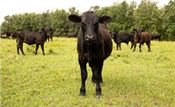|
Arkansas Beef Council Awards Research Grants To Division Of Agriculture Scientists

The Arkansas Beef Council has awarded grants to Division of Agriculture animal scientists
working to improve beef production.
U of A System Division of Agriculture photo by Fred Miller
FAYETTEVILLE, ARK.
The Arkansas Beef Council awarded research grants to four University of Arkansas System Division of Agriculture scientists in the department of animal science.
The Beef Council coordinates a program of promotion, research and market development to enhance the image of beef and improve the potential of Arkansas’ cattle industry, according to information from the council.
“The department greatly appreciates the Beef Council’s support of our faculty’s research efforts,” said Michael Looper, animal science department head.
The researchers receiving the council’s funding include Brittni Littlejohn, assistant professor; Kelly Vierck, assistant professor; Charles Looney, professor; and Janeal Yancey, program technician. All are research faculty and staff of the Division of Agriculture’s Arkansas Agricultural Experiment Station.
Littlejohn’s project focuses on the genetics of marbling in three different muscle types in cattle.
Marbling is a key factor in beef quality, Littlejohn said. “It is well established that marbling plays a profound role in beef tenderness, flavor, juiciness and overall eating experience.”
Littlejohn is working to identify the genetic pathways that regulate marbling in different muscle types of beef cattle. What she learns in this study will guide continuing research to evaluate potential treatments to control those pathways without genetic modification in order to improve marbling to match consumer tastes.
The Beef Council has funded two of Vierck’s projects. In the first, she is examining the impacts of aging on bone-in versus boneless steaks. She aims to determine the impact of boneless vs. bone-in and aging duration on consumer ratings and volatile flavor products of beef loin steaks.
Using consumer sensory analysis, volatile compound analysis and other analytical tools, Vierck seeks to discover whether bone-in products can match or exceed boneless for flavor, tenderness and other traits consumers find desirable.
In her other project, Vierck is investigating whether sous vide – a cooking method in which food is sealed in a plastic or glass vacuum container and slow cooked in a circulating water bath – can improve the taste and tenderness of meat cuts that are typically prone to being tough when using a dry cooking method such as on a grill.
Sous vide is becoming more popular in restaurants and retail food outlets, Vierck said. She wants to see if it has the potential to improve the consumer preference and marketability of meat cuts usually considered less desirable.
Looney’s project is aimed at helping beef producers to predict quality when selecting cattle for direct marketing to consumers.
“Our proposal is mainly one of education about using technology to select and predict cattle that will produce a quality end product,” Looney said. “We intend to make valid comparisons using beef produced by direct marketed programs and beef produced by commodity beef programs.”
He will use ultrasound and genomic testing – both research-proven tools – to estimate carcass yield and meat quality. His aim is to show that these technologies can help producers who direct-market their beef to consumers improve the quality of their products, making them comparable to commodity beef products sourced by retail meat outlets.
Yancey is working to determine the effect of innovative retail display cases donated by Hillphoenix, a manufacturer of refrigerated display cases and related products, on the shelf life of beef.
“We have two types of cases, an open-front case like you would see in Walmart or Harps and a door-front case, and two types of lights,” Yancey said. “The door-front cases use about 40 percent less energy than the open front cases.”
Ground beef patties packaged in foam trays with plastic overwrap were in each display for seven days and colors were measured each day. Patties were also removed for oxidation analysis at regular intervals.
After data are analyzed, Yancey expects to show whether the new display cases have advantages over those commonly in retail use. ∆
|
|